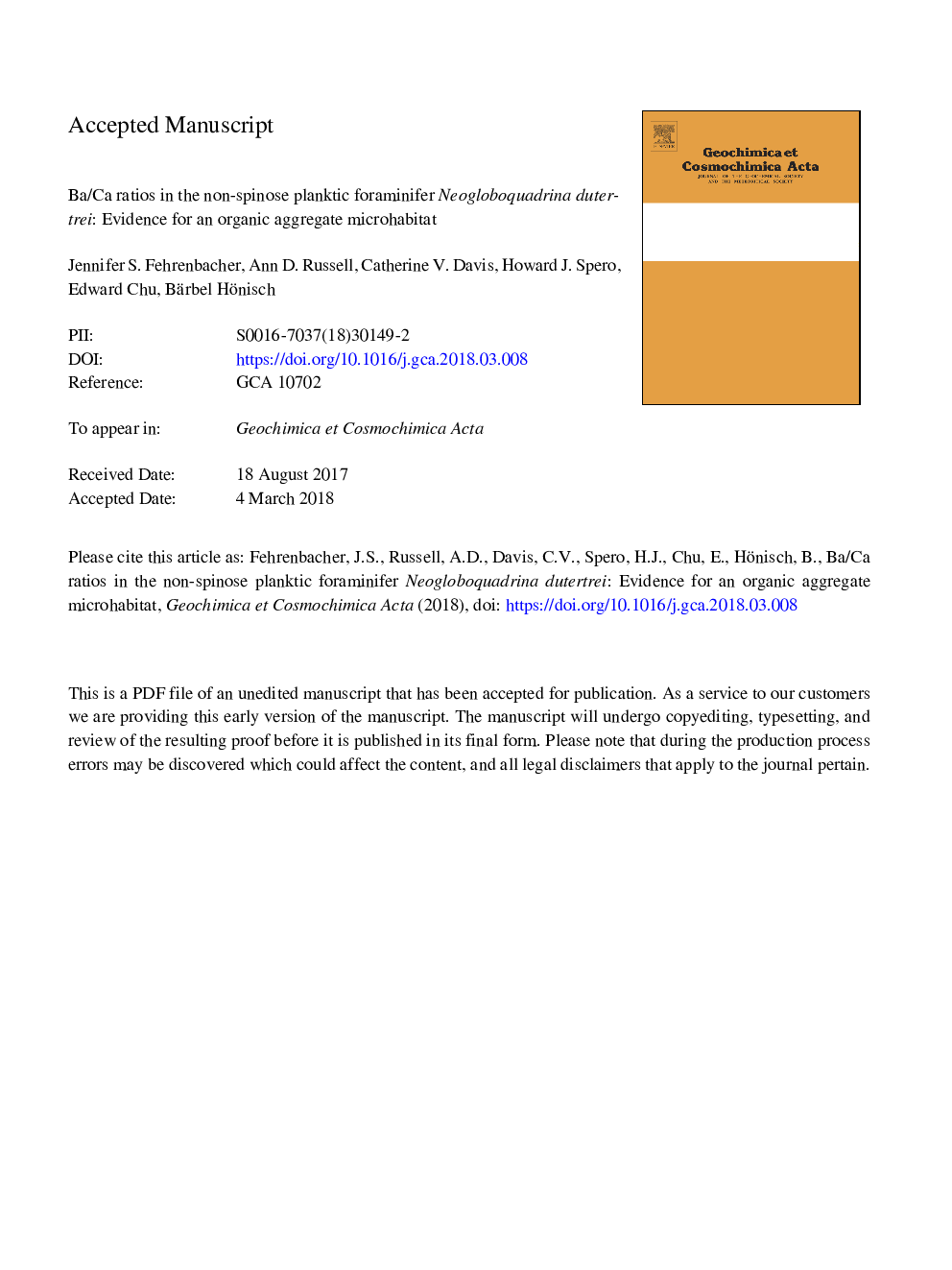| کد مقاله | کد نشریه | سال انتشار | مقاله انگلیسی | نسخه تمام متن |
|---|---|---|---|---|
| 8910663 | 1637921 | 2018 | 36 صفحه PDF | دانلود رایگان |
عنوان انگلیسی مقاله ISI
Ba/Ca ratios in the non-spinose planktic foraminifer Neogloboquadrina dutertrei: Evidence for an organic aggregate microhabitat
دانلود مقاله + سفارش ترجمه
دانلود مقاله ISI انگلیسی
رایگان برای ایرانیان
موضوعات مرتبط
مهندسی و علوم پایه
علوم زمین و سیارات
ژئوشیمی و پترولوژی
پیش نمایش صفحه اول مقاله

چکیده انگلیسی
Ba/Ca ratios in many non-spinose planktic foraminifera are markedly higher than those observed in spinose planktic species, but the cause for these high Ba/Ca ratios is not understood. A better understanding of this geochemical anomaly could provide insights into the habitat and/or controls over Ba incorporation in these species and expand their utility in paleoclimate research. In spinose species, shell Ba/Ca depends only on the Ba/Ca ratio of seawater. Proposed explanations for high non-spinose Ba/Ca include (1) the empirical partition coefficient, DBa, differs from the spinose species, (2) shell Ba varies with seawater temperature and pH, or (3) non-spinose foraminifers have a preference for prey that has elevated Ba. We performed laboratory culture experiments to determine DBa for the thermocline-dwelling non-spinose planktic foraminifer Neogloboquadrina dutertrei. We find that the Ba/Ca ratio of foraminiferal calcite secreted in the laboratory varies linearly with the Ba/Ca ratio of the seawater. The DBa for this species, 0.11â¯Â±â¯0.008 (2SE; 95% CL), is similar to the DBa for spinose species (0.13â¯Â±â¯0.004, 2SE; 95% CL). As in spinose species, the Ba/Ca ratio of cultured specimens of N. dutertrei is not influenced by culture temperature (12-22â¯Â°C) or seawater pHNBS (range 7.8-8.3). However, the Ba/Ca ratio of individual plankton-tow N. dutertrei specimens that completed their lifecycle in the ocean exceeds the Ba/Ca ratio of cultured specimens by up to three orders of magnitude. It is unlikely this difference between cultured specimens and ocean-grown specimens is due to seawater [Ba] variability, since seawater Ba/Ca ratios calculated using our DBa are much higher than exist in the ocean. Rather, we suggest that elevated shell Ba/Ca in plankton tow and fossil N. dutertrei is due to calcification in the microenvironment of marine organic aggregates such as marine snow, where [Ba] is elevated as a result of Ba release from biogenic particulates.
ناشر
Database: Elsevier - ScienceDirect (ساینس دایرکت)
Journal: Geochimica et Cosmochimica Acta - Volume 236, 1 September 2018, Pages 361-372
Journal: Geochimica et Cosmochimica Acta - Volume 236, 1 September 2018, Pages 361-372
نویسندگان
Jennifer S. Fehrenbacher, Ann D. Russell, Catherine V. Davis, Howard J. Spero, Edward Chu, Bärbel Hönisch,